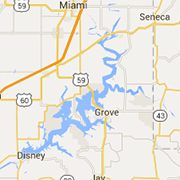Celebrating 80 in 2020 Finding the right mix to build Pensacola Dam

As we continue to celebrate Pensacola Dam’s 80 years of service to Oklahoma, we are exploring the many different stories surrounding the dam, Grand Lake and all those who helped to make it possible. This week, we wanted to share a little fact about the dam’s construction …
The construction of Pensacola Dam in the late 1930s called for a lot of earth excavation, a lot of steel and a lot of concrete in cement. In fact, it took 625,000 barrels of cement and 510,000 cubic yards of concrete to bring the dam’s 51 iconic arches and its powerhouse out of the ground and into completed reality.
Still, W.R. Holway, the chief engineer on the construction project, knew that getting the right materials to the construction site – especially the right type of cement mixture – may prove challenging. However, thanks to important pre-planning and cooperation on the part of many suppliers, the materials and manpower all came together at the right place and time. Here’s how Holway recalled that effort in his book, A History of the Grand River Dam Authority (1968):
“… It was necessary to obtain cement of a special type in order to maintain a fast schedule of pouring the arches and buttresses. We arranged as several-day conference in Tulsa with the managers and chief chemists of all the cement plants in the area (Oklahoma, Texas, Missouri and Kansas). No one plant in this area was equipped to produce the quantity of this special type of cement (Type 2), but at this conference it was arranged that several plants would join to furnish the necessary quantity in the time required.”
That little bit of teamwork is another reason we can celebrate Pensacola Dam’s 80th birthday in 2020. Look for more stories about the dam’s history throughout the year.
GRDA is Oklahoma’s state-owned electric utility; fully funded by revenues from electric and water sales instead of taxes. Each day, GRDA strives to be an “Oklahoma agency of excellence” by focusing on the 5 E’s: electricity, economic development, environmental stewardship, employees and efficiency.
# # #






